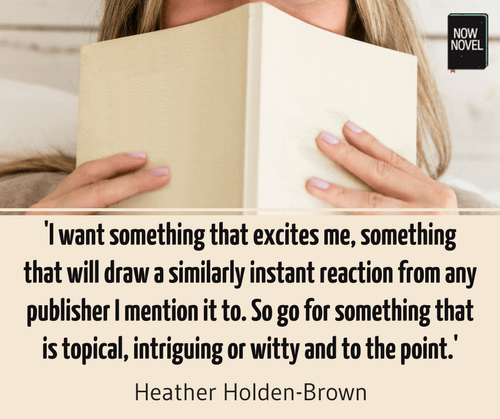What is a synopsis? It's a summary which provides, in one quick read, the unique and compelling aspects of a story. How do you write a synopsis that you can submit with confidence to publishers? Read on for summary-writing tips and examples.
First: Beyond defining a synopsis - what should a synopsis include?
Yes, a synopsis is a summary and yes, the word means 'seeing together', but what does the typical synopsis for (for example) a typical mystery-thriller or fantasy epic include?
On their submissions page, Bloomsbury (who published J.K. Rowling's mega-hit Harry Potter series), specify what they require in a synopsis. It should include:
- 'The story's subject matter' - what it's about
- 'Your intended market' - for example, teenage fantasy genre lovers
- 'How your submission compares with the current competition'
This third item may seem confusing. Bloomsbury isn't asking you to say 'My novel is much better than the work of that George R. R. Martin guy'. Instead, the publishers want to know you understand your audience and genre. For example, you might say in a submission:
The Lost Throne, in the vein of George R. R. Martin's A Song of Ice and Fire Series, unpacks the feuds and allegiances between powerful families in a struggle for succession. Yet it is closer to Le Guin's Earthsea novels, as the protagonist's development demonstrates the relationship between power and responsibility.
This could be worded more succinctly - the main thing is it shows an awareness of both recent and older writing that has a similar target audience.
Why should I write a synopsis?
What is a synopsis used for? As described above, a synopsis is a crucial component of submitting your manuscript to most traditional publishers.
Publishers, before they even consider leafing through the first page of your manuscript, will want an overarching sense of the story. Synopses help publishers:
- Tell apart submissions that explore fresh, exciting subject matter from cliched tropes (e.g. sparkly vampires)
- Decide which manuscripts to prioritize (according to the quality and interest of the synopsis and what subject matter they're presently most interested in producing)
- Set expectations for your submission: If a synopsis is worded badly, clunky, uninteresting or disjointed, the odds are high the submission itself will have similar faults
Because of the above, it's crucial to weed out inessential words and find ways to summarize the subject matter of your story (and your knowledge of your market) in a commanding, professional way.
Writing synopses is also a useful exercise for outlining a story idea, before you reach the publishing stage. Expanding your one-sentence idea into a trio of more detailed synopses is a key step in Week 2 of our 6-week Kickstart your Novel course, designed to help you complete all that you need to pitch your best ideas to publishers.
So how do you write a book synopsis that will captivate professional and casual readers alike? Here are our top 9 tips:
1. When writing a book synopsis, make the opening good
Just as a first chapter should make the reader want to know more, a good synopsis opening makes the reader want to know more about the characters, events and potential conflict of your novel.
Published author Marissa Meyer provides the following advice on her blog:
The first paragraph of the synopsis should give the same basic information you convey through the book’s first chapter: where and when does this story take place, who is the protagonist, and what problem are they facing right off the bat?
2. Stick to compelling essentials
Does your character wake up in one scene and have a full English breakfast? You might have a great way with describing food mouth-wateringly. Even so, leave out everything that doesn't give the reader an idea of character development, key plot twists and turns, and any conflicts and resolutions. This will communicate that your book has a strong underlying creative purpose.
Purposeless waffle has no place in a synopsis or a strong final draft. For every line you write in your synopsis, ask, 'What valuable information does this give the reader about my book? Why would it motivate a person to read more?'
3. Don't give a dry account of the core plot events
Jane Friedman who's had a successful career in the publishing industry makes this her number one 'don't'. Says Jane, 'A synopsis includes the characters’ FEELINGS and EMOTIONS. That means it should not read like a mechanic’s manual to your novel’s plot. You must include both story advancement and color.'
Here's a book synopsis example that does exactly this. It's the summary for An American Marriage (2018) by Tayari Jones, an NYT bestseller and Oprah's Book Club pick:
'Newlyweds Celestial and Roy are the embodiment of both the American Dream and the New South. He is a young executive, and she is an artist on the brink of an exciting career. But as they settle into the routine of their life together, they are ripped apart by circumstances neither could have imagined. Roy is arrested and sentenced to twelve years for a crime Celestial knows he didn’t commit. Though fiercely independent, Celestial finds herself bereft and unmoored, taking comfort in Andre, her childhood friend, and best man at their wedding.'
The synopsis is full and detailed without giving away the core, pleasurable surprises of the story. We get the general gist, but not too much detail. We see the starting scenario - a couple's marital bliss - as well as glimpsing the trouble ahead. This emotional and dramatic element - the promise of a changing situation - compels.

4. Give situation and complication alike
As writers, we do sometimes like to waffle. But the only good waffle is a Belgian one. In your synopsis, you need to be concise. It's important to give both the initial situation and a glimpse of complications that make your main plot line exciting. Instead of saying:
'Robert Bluthe is a tough detective who has eggs Benedict for breakfast every day and is investigating a double homicide at the start of the book', say:
'Robert Bluthe, a tough detective and man of unswerving habit, investigates a double homicide that forces him to question everything he knows about investigative procedures.'
The second example gives not only the situation (the double homicide) but also the complication and stake for the character (a novel aspect to the crime that makes traditional problem-solving methods ineffective).
5. Stick to using active voice compellingly
Courtney Carpenter shares this tip in a useful post for Writer's Digest, 'Learn How to Write a Synopsis like a Pro'. Rather than say 'The protagonist is married by...' say 'The protagonist marries'. Make each action described in the summary of your story's events seem a decisive event that drives the plot forward.
Carpenter also suggests sticking to the third person ('he', 'she', 'they') since your synopsis should read as an author standing apart describing her character's lives and developments as an observer.
6. Make every single word count
This follows on from point three. Besides keeping your synopsis concise, make sure that the words you do use carry emotive and imaginative weight. Don't say 'after the wedding there is some trouble during the honeymoon' but 'the honeymoon is disastrous. After the newlyweds miss their flight, they must [describe challenge action] and this tests their [positive state they wish to maintain]'.
Make sure each word creates a vivid emotional or descriptive pull. Make the reader curious to know more and expand their knowledge of how your story unfolds.
7. Read your book synopsis aloud
This is common advice for writing better narrative prose. It's also equally good advice for writing a compelling book synopsis. While reading aloud, ask yourself:
- Does each sentence communicate something that improves the reader's overall grasp of what the story is about and what makes it interesting?
- Does each sentence flow smoothly with no unnecessary words or awkward constructions?
- Is there any part that feels boring or irrelevant to the overall story development?
8. Use the synopsis format your intended reader prefers
What is a synopsis that doesn't stick to publishers' preferred guidelines? Usually, an ignored synopsis. Formatting a book synopsis in a simple, elegant way is important.
Fiction Writer's Connection provides this format:
-
- In the upper left hand corner, writes 'Synopsis of "[Title of your novel]"
- This should be followed by a space and a description of your novel's genre: 'Genre: [Genre of your novel]'
- This should be followed by 'Word count: [Word count of your novel]
- Finally, in the right-hand upper corner, you should put your name: 'By: [Your pen name]'
The heading of a synopsis for J.K. Rowling's first Harry Potter book might look something like this:

If your synopsis only spans a single page, single space your lines. Ideally, it shouldn't be longer than one page. If it is, double-space it.
See if you can find publishers' preferred synopsis format on their website (or simply ask in an email or on social media). If they have a preferred format, they'll share it.
9. Don't include irrelevant cover material
Do you have a degree in linguistics? A favourite Abba song? Don't include any personal or quirky information as an addendum to your synopsis - keep it professional.
Biographical information should be kept for author bio material if it is requested. A synopsis doesn't need a cover page. Ideally it's a single page that the eagle-eyed editor can wave at colleagues frantically while shouting, 'You won't believe how great this novel sounds!'
Get guidance creating your story's synopsis (and detailed feedback on this and your first three chapters) when you complete Kickstart your Novel. Learn more about Now Novel's online writing courses here.









What are your top tips for writing a synopsis?
Bridget At Now Novel - Over 9 years ago
While it is important to be able to write a good review about a book you've read, it's not germane to the above article. In my opinion, the more you read, the better you'll write. The author of the article is asking readers to inform said writer if anything important was overlooked, nothing more.
Dennis De Rose - Over 7 years ago
Thank you, Dennis. The prior comment was actually spam it appears, it somehow slipped through the net. I've deleted it.
Bridget At Now Novel - Over 7 years ago
Excellent reference! Bookmarked it! One thought: perhaps bullet 9 should be the first bullet?
Egan Mc Knight - Over 7 years ago
Thanks, Egan. Good suggestion. I'll add it to my list of blog updates to do. Thank you for reading!
Bridget At Now Novel - Over 7 years ago
Wow! What a great site you have here with such useful information, I am just about to start the synopsis for my very first book and it is giving me angst, the info you have provided is extremely helpful. A huge thank you.
Victoria Hannah - About 7 years ago
Hi Victoria, I'm so glad to hear that. I hope it's all coming together well. Good luck with submission!
Bridget At Now Novel - About 7 years ago
Thank you Bridget. ?
Victoria Hannah - About 7 years ago
It's difficult and Thanks! I just wrote one!! https://universeofmysecrets.blogspot.com/2018/09/secrets-synopsis.html
Dhiraj The Reader - Over 6 years ago
I've found it helpful to review the 5-W's and add a "How"; (the) Who, What, Where, When, Why, & How. At a paragraph apiece, easily grants the 300/500-word format.
Jake - Almost 4 years ago
Good addition, the 'how'. Thanks for sharing that, Jake.
Jordan - Almost 4 years ago